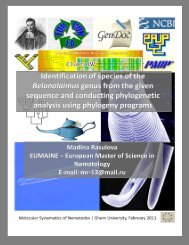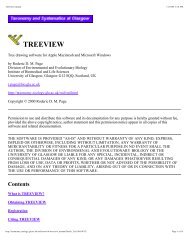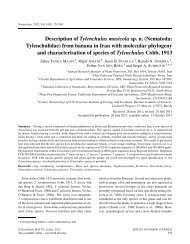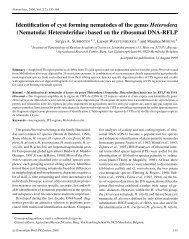Variations in ribosomal DNA sequences and phylogeny of - Russian ...
Variations in ribosomal DNA sequences and phylogeny of - Russian ...
Variations in ribosomal DNA sequences and phylogeny of - Russian ...
Create successful ePaper yourself
Turn your PDF publications into a flip-book with our unique Google optimized e-Paper software.
Ribosomal <strong>DNA</strong> <strong>and</strong> <strong>phylogeny</strong> <strong>of</strong> Globodera<br />
Table 3. Sequence differences between clones from studied Globodera rostochiensis(Gr) populations from Russia <strong>and</strong> UK.<br />
ITS1 <strong>and</strong> Clones ITS1 5.8S ITS2<br />
ITS2 types 281 288 297 358 624 863 891 912 918 949 964 973<br />
Aa Ga1, Tu1, Ro1 C G T G – C T A A T T T<br />
Bb Ga2, Kh1, Ja1, Ja2, Ro3 C G G G T C C – T T T T<br />
Cc Ga3, Kh2, Tu2 T A G A – T T A T C G G<br />
Cb Ro2 T A G A – C C – T T T T<br />
Orig<strong>in</strong>al <strong>sequences</strong> <strong>of</strong> G. pallida <strong>and</strong> three subspecies<br />
<strong>of</strong> G. tabacum had lengths <strong>of</strong> 1193 <strong>and</strong> 1194 bp, respectively.<br />
Six po<strong>in</strong>t mutations, three <strong>in</strong> ITS1 <strong>and</strong> three <strong>in</strong><br />
ITS2, were observed between the � ve clones <strong>of</strong> the G. pallida<br />
population,enabl<strong>in</strong>grecognition<strong>of</strong> three types <strong>of</strong> ITS<br />
regions (Aa, Bb <strong>and</strong> Cb) (Table 4). One po<strong>in</strong>t mutation <strong>in</strong><br />
the 18S gene (132 position — G/A) between two clones<br />
<strong>of</strong> G. tabacum virg<strong>in</strong>iae <strong>and</strong> three po<strong>in</strong>t mutations: two<br />
<strong>in</strong> the 18S gene (128 position — A/T, 180 position C/T)<br />
<strong>and</strong> one <strong>in</strong> the ITS2 (1060 position — G/A) between two<br />
clones <strong>of</strong> G. tabacum solanacearum were found, respectively<br />
(Fig. 2). There were no differences between the two<br />
clones <strong>of</strong> G. tabacum tabacum.<br />
Sequence characteristics <strong>of</strong> the ITS regions <strong>and</strong> the<br />
5.8S gene for Globodera species based on analyses <strong>of</strong><br />
orig<strong>in</strong>al <strong>and</strong> published data are given <strong>in</strong> Table 5. Sequence<br />
divergence with<strong>in</strong> Globodera species ranged from 0 to<br />
4.47% (Table 5), <strong>and</strong> that between C. estonica <strong>and</strong> Cactodera<br />
sp. was 4.06%. The ITS1 region <strong>of</strong> Globodera was<br />
less divergent than ITS2 <strong>and</strong> had relatively higher G + C<br />
contents.<br />
RFLP ANALYSIS OF THE ITS REGION<br />
All enzymes cut the PCR product obta<strong>in</strong>ed from population<br />
Gr-Ga (Fig. 2A). The total length <strong>of</strong> the fragment<br />
sizes produced by NdeI <strong>and</strong> SphI was greater than the size<br />
<strong>of</strong> the ampli� ed PCR product, <strong>in</strong>dicat<strong>in</strong>g a heterogeneity<br />
<strong>of</strong> ITS regions present <strong>in</strong> the genome <strong>of</strong> this population.<br />
Repeated digestions with extended periods suggest<br />
that this heterogeneityis not the result <strong>of</strong> partial digestion.<br />
Subsequently,six restriction enzymes, SphI (Fig. 3A), StyI<br />
(Fig. 3B), Bsh1236I, CfoI, Sau3A, NdeI (data not shown)<br />
were used to test for RFLPs <strong>in</strong> the PCR product from<br />
the other eight G. rostochiensis populations. Enzymes<br />
Bsh1236I, CfoI <strong>and</strong> Sau3A did not show any differences<br />
<strong>in</strong> patterns between populations or any heterogeneity <strong>of</strong><br />
the ITS regions.<br />
Analysis <strong>of</strong> digested PCR products separated on high<br />
resolution synthetic meltable OligoPrep gels showed that<br />
Table 4. Sequence differences between clones from a Globodera<br />
pallida (Gp) population from UK.<br />
ITS1 <strong>and</strong> Clones ITS1 ITS2<br />
ITS2 types 529 635 660 972 1036 1081<br />
Aa Pa1 G T C C T T<br />
Bb Pa2, Pa3 G C T T C C<br />
Cb Pa4, Pa5 A C T T C C<br />
all products from the G. rostochiensis populations were<br />
partially digested by NdeI, SphI <strong>and</strong> StyI <strong>and</strong> that heterogeneity<br />
<strong>in</strong> the ITS regions probably occurred <strong>in</strong> all populations.<br />
Positions 281, 624 <strong>and</strong> 863 lay with<strong>in</strong> NdeI, StyI<br />
<strong>and</strong> SphI recognition sites, respectively, which meant that<br />
these enzymes would cleave only ITS1 type C, ITS1 type<br />
B <strong>and</strong> ITS2 type c, respectively. However, StyI showed<br />
different levels <strong>of</strong> digestion <strong>in</strong>tensity <strong>and</strong> this may <strong>in</strong>dicate<br />
polymorphism between populations. No restricted fragments<br />
were observed <strong>in</strong> populationsGr-Ka <strong>and</strong> Gr-Vl <strong>and</strong><br />
the <strong>in</strong>tensity <strong>of</strong> digested fragments was much less for Gr-<br />
Tu, Gr-Ga <strong>and</strong> Gr-Ro, than for Gr-Sm, Gr-Ja, Gr-Ps <strong>and</strong><br />
Kh (Fig. 3B). Thus, RFLP data showed that, <strong>in</strong> the mixture<br />
<strong>of</strong> different ITS types for the populations<strong>of</strong> G. rostochiensis,<br />
at least ITS1 types C <strong>and</strong> A or B <strong>and</strong> ITS2 types c <strong>and</strong><br />
a or b were present.<br />
Eight restriction enzymes (AluI, Bsh1236I, CfoI, H<strong>in</strong>fI,<br />
NdeI, RsaI, Sau3A <strong>and</strong> SphI) were used to study the<br />
PCR product from the UK population <strong>of</strong> G. pallida. All<br />
the enzymes, except for NdeI <strong>and</strong> SphI, cut the product<br />
(Fig. 2B). Each <strong>of</strong> these eight enzymes generated patterns<br />
which clearly dist<strong>in</strong>guished G. rostochiensis from<br />
G. pallida. Enzymes Bsh1236I <strong>and</strong> RsaI produced additional<br />
weak b<strong>and</strong>s, <strong>in</strong>dicat<strong>in</strong>g heterogeneity <strong>of</strong> the ITS regions.<br />
Repeated digestions with extended periods suggest<br />
that this heterogeneityis not the result <strong>of</strong> partial digestion.<br />
PHYLOGENETIC ANALYSIS<br />
The g1 statistics calculated from 10 000 r<strong>and</strong>om trees<br />
for the ITS1 <strong>and</strong> entire ITS alignments <strong>in</strong>dicated that the<br />
Vol. 2(6), 2000 597
















